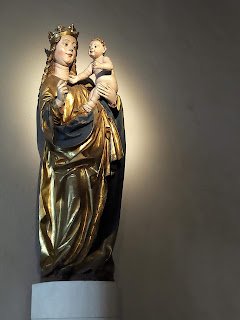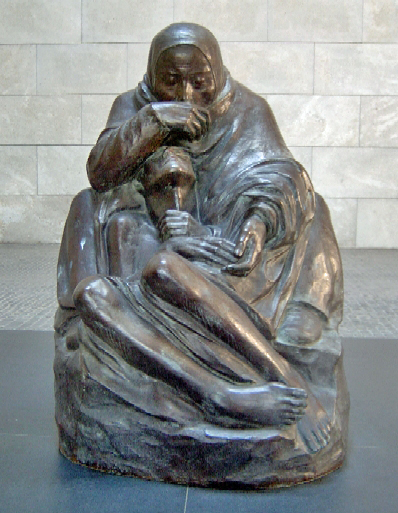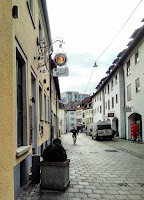On purpose, I didn't get out of the train until I reached Marienplatz, the best starting point for any walk through München. At the S and U signs in my picture is the station exit.
Nearby is the famous, year-round farmers' market, the Viktualienmarkt, where I went next, its stalls full of intriguing smells and colours and unusual things for sale, such as the wooden ducks and fruit bearing orange tree shown below, opposite the saure Gurken:
With frequent references to the street map I'd picked up, I then found my way via the famous Hofbräuhaus (didn't go in) and behind the princely Residenz to the Hofgarten, looking dull at this time of year with bare branches and the fountains covered. The pathways were muddy today. I'd have to wait until May to see the chestnut trees in full, pink bloom. Its symmetrical layout is still attractive.
 As I emerged from the Hofgarten, I could hear shouting from a loud-speaker and cheers from a crowd in the Franz-Joseph-Platz, so out of curiosity I went to see what was happening. It being Friday, a German school strike For The Future of our planet was in full swing, with some people of my age supporting it. I stayed and watched for a while. Directed from two students standing on a red truck and sharing a megaphone, the youngsters were staging a die-in: "Everyone run and lie on the ground, and when I tell you to get up, get up and sing Power to the People. You'll know the words, or if you don't, you'll soon pick them up!"
As I emerged from the Hofgarten, I could hear shouting from a loud-speaker and cheers from a crowd in the Franz-Joseph-Platz, so out of curiosity I went to see what was happening. It being Friday, a German school strike For The Future of our planet was in full swing, with some people of my age supporting it. I stayed and watched for a while. Directed from two students standing on a red truck and sharing a megaphone, the youngsters were staging a die-in: "Everyone run and lie on the ground, and when I tell you to get up, get up and sing Power to the People. You'll know the words, or if you don't, you'll soon pick them up!"
Having symbolically lain down and been resurrected, the students and their supporters then processed elsewhere, some of them dragging the truck along by means of a strong rope.
 |
| "Climate Justice! Keep it in the ground!" |
From there it was a longish walk round the back of the Frauenkirche onto Kaufingerstraße (finding the Dirndl and Lederhosen store closed for renovations) and so to Karlsplatz with the imposing Palace of Justice opposite. Behind the Justizpalast is the Alter Botanischer Garten, which to my delight had real spring flowers blooming under the trees: snowdrops and winter aconites. Some trees were already bearing spring blossoms too. And the sun was coming out! I sat on a bench for a while, not feeling cold at all.
My destination for the afternoon was an art museum I'd never visited on my previous visits to Munich, the Lenbachhaus, a fine example of Bauhaus architecture. It houses a large permanent collection of paintings from the school of art known as Der Blaue Reiter, named after a picture painted by Kandinsky in 1903. Rather than read all about this from me, because I'm beginning to think I ought to be asleep in bed instead of typing, click on the link above to learn more. I felt thoroughly excited by what I found in this museum, as I've seen exhibitions of art by these same artists elsewhere and appreciate it. Nowhere have I ever before seen so many paintings by Kandinsky in one place.
 |
| This is from a very early animated film, created by Lotte Reiniger in 1926. It is The Adventures of Prince Achmed, a story based on ideas from the 1001 nights. |
 |
| Three Kandinskys in a row. There were Kandinsky paintings galore. |
 |
| Another interpretation of an Archangel, this one by Paul Klee, a friend of the Munich artists |
 |
| Stairway decoration at the Lenbachhaus |
"You are an enthusiastic one, aren't you?" comments my husband, after reading this blogpost.
















































